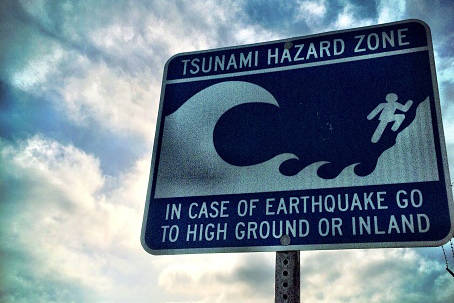As warm weather approaches the coast and mountains are popular destinations to enjoy activities such as hiking, camping and get-a-ways to the beach. Although these are nice places to visit they harbor hidden threats in the form of volcanoes and tsunamis. Preparing ahead of time can go a long way in keeping you and your family safe. Signing up for local alerts through the Snohomish County alert and warning system, SnoCoAlerts is a good start.
Five active volcanoes in Washington State
With the recent dramatic eruption of Mt Kilauea in Hawaii, officials in West Coast states, including Washington, are reminding residents and visitors about appropriate safety precautions.
There are five active volcanoes in Washington, including Glacier Peak in Snohomish County. Through seismic monitoring, officials can usually offer some warning of an eruption, but there won’t always be much lead time.
In addition to local alerts, the United States Geological Survey’s Volcanic Notification System can also provide information of imminent volcanic activity.
Here’s what to do during volcanic activity:
- Follow evacuation orders from local authorities. Evacuate early.
- Avoid areas downwind and river valleys downstream of the volcano. Rubble and ash will be carried by wind and gravity.
- Take temporary shelter from volcanic ash where you are if you have enough supplies. Cover ventilation openings and seal doors and windows.
- If you are outside, protect yourself from falling ash that can irritate skin and injure breathing passages, eyes, and open wounds.
Listen for tsunami warnings
When visiting coastlines in Washington, be aware that tsunamis are a devastating force, and open stretches of Washington’s coastlines are vulnerable.
There are signs a tsunami may be imminent. Seawater may recede quickly, or the ground may shake, indicating that there has been an earthquake.
The National Oceanic and Atmospheric Administration (NOAA)’s tone alert radio will issue a warning that a tsunami may be headed your way. If there is an advisory or warning issued by the National Tsunami Warning Center, it’s important to know how to react.
- Go to higher ground immediately or evacuate inland. Ideally, try to get 50 feet above sea level. If you don’t have time to get to high ground, but are in a multi-story building, go to an upper level of the building.
- If you are on the beach and unable to get to high ground, go inland as far as you can. Go on foot if possible, particularly if an earthquake has caused damage to roads, power lines, and resulted in significant debris.
- Do not return to shore after the first wave and stay out of the water! Tsunamis usually occur as a series of waves. Wait until the official tsunami warning or advisory has been lifted.
- Never go to the coast to watch a tsunami. Tsunamis move faster than a person can run, and seemingly small waves move with deadly force and can carry debris that can injure you.
For up to date information, sign up for emergency alerts through the emergency management office where you are visiting or check the National Weather Service current tsunami activity.

























